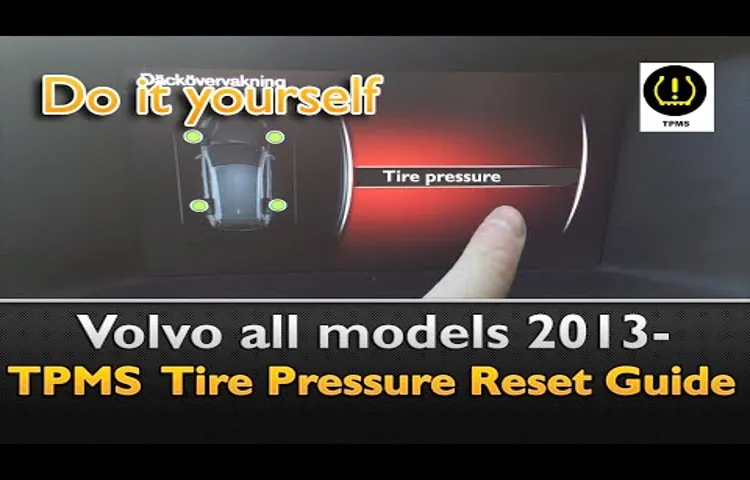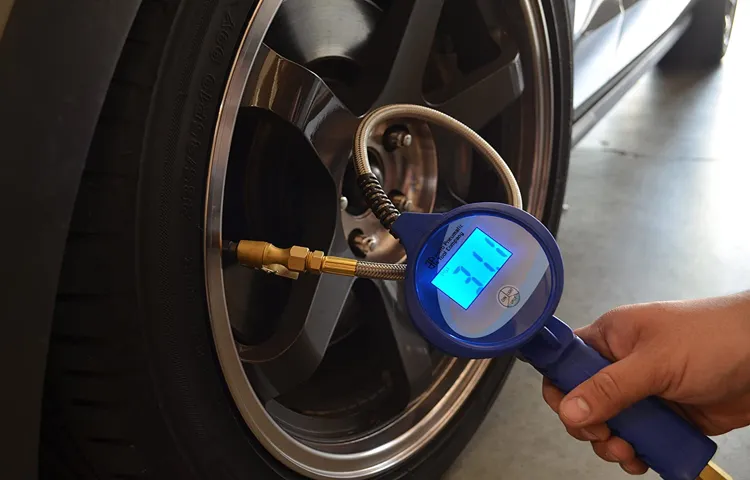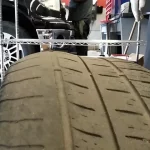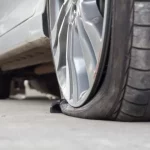Have you ever wondered how important it is to check your tire pressure regularly? The answer is that it’s crucial to ensure not only your safety but also the longevity of your vehicle. As a Volvo XC60 owner, you’ll want to ensure that your tires are properly inflated and functioning correctly. In this blog post, we’ll guide you step-by-step on how to check tire pressure on a Volvo XC60.
Don’t worry; it’s not rocket science, and you won’t need any special tools or equipment. With a few easy-to-follow steps, you’ll become a tire pressure checking pro in no time! So, let’s get started!
Table of Contents
Why Checking Tire Pressure is Important
Maintaining proper tire pressure is crucial to ensure the longevity of your Volvo XC60’s tires, as well as improve fuel efficiency and overall safety on the road. Checking your tire pressure regularly is a simple and straightforward process that can be done at home with a tire pressure gauge. Start by unscrewing the valve cap on the tire and firmly pressing the gauge onto the valve stem.
The gauge will quickly display the current tire pressure, which should match the recommended pressure listed in your vehicle’s owner manual or on the inside of the driver’s side door. If the pressure is too low, use an air compressor to fill the tire to the appropriate level. Taking a few minutes once a month to check your tire pressure can go a long way in preventing unnecessary wear and tear on your tires and keeping you safe on the road.
Prevents Accidents
Tire pressure is essential for a smooth and safe driving experience. Overinflated or underinflated tires can lead to accidents or even tire blowouts, causing devastating consequences. Checking your tire pressure regularly can save your life and protect your vehicle.
Low tire pressure reduces your tires’ ability to grip the road, leading to a decrease in vehicle control, longer stopping distances, and decreased fuel efficiency. Conversely, high tire pressure can damage your vehicle’s suspension system, resulting in a bumpy ride. Therefore, it’s crucial to keep your tires inflated to the manufacturer’s recommended pressure levels.
Remember, prevention is always better than cure, so conduct routine tire pressure checks and save yourself from possible accidents.

Improves Fuel Efficiency
Checking tire pressure may seem like a small task, but it can have a big impact on your fuel efficiency. When your tires are not properly inflated, it can cause your vehicle to work harder to move, which results in using more fuel. According to the U.
S. Department of Energy, for every one PSI drop in tire pressure, your fuel efficiency can decrease by 0.4 percent.
That may not sound like a lot, but the cumulative effect can add up over time. Regularly checking and maintaining your tire pressure can help you save money on gas and lower your carbon footprint. Plus, it can also increase the lifespan of your tires and ensure a smoother, safer ride.
So next time you’re at the gas station or getting your oil changed, don’t forget to ask your mechanic to check your tire pressure. It’s a quick and easy way to improve your fuel efficiency and save money in the long run.
Increases Tire Lifespan
Maintaining proper tire pressure is crucial for a smooth and safe driving experience. It not only improves your car’s handling, but it also increases your tire lifespan. When your tires are underinflated, the sidewalls of the tire flex more, generating excessive heat, which leads to tire failure and reduces the lifespan of the tire.
Conversely, over-inflated tires become stiffer and cause a harsher ride, which can also decrease the lifespan of the tire. Therefore, it’s important to check your tire pressure regularly to ensure they are properly inflated. It’s an easy task that can help extend the lifespan of your tires and save you money in the long run.
A good rule of thumb is to check your tire pressure once a month, or before any long journey. So, take the time to check your tire pressure and give yourself peace of mind on the road.
Locating the Tire Pressure Monitoring System
One of the essential tasks that every car owner must perform regularly is to check the tire pressure. This is not only to ensure the smooth running of the vehicle, but also for safety reasons. On the Volvo XC60, the tire pressure monitoring system (TPMS) is located in the instrument cluster.
TPMS alerts the driver if the pressure in any of the tires drops below the recommended level, indicating possible leakage or punctures. To check the tire pressure on a Volvo XC60, you can either use a tire pressure gauge or the TPMS. Using a gauge ensures accurate readings, while the TPMS provides real-time updates.
Both of these methods are simple and quick ways to ensure that the tires are inflated to the correct pressure and prevent any potential tire damage. By keeping your tires properly inflated, you’ll also enjoy better fuel economy, improved handling, and a smoother ride. Make sure to check your tire pressure regularly to avoid any potential hazards when driving.
Step-by-step Guide
It’s important to keep an eye on the tire pressure of your vehicle in order to ensure its proper functioning and safety on the road. One way to do this is by utilizing the Tire Pressure Monitoring System (TPMS), which is designed to alert you when your tires are below the recommended pressure level. So how do you locate the TPMS in your vehicle? Well, it depends on the make and model, but generally, the TPMS is located on the dashboard and looks like a small icon with an exclamation point inside a horseshoe-shaped tire.
Alternatively, some vehicles have a more detailed TPMS display which can be accessed through the central console or the infotainment system. Either way, once you locate the TPMS, make sure to check it regularly as it can help prevent accidents and extend the life of your tires.
Using a Tire Pressure Gauge
To ensure safe driving and optimal fuel efficiency, it’s important to check the tire pressure of your Volvo XC60 regularly. One of the easiest and most accurate methods is by using a tire pressure gauge. This tool can be found at any auto parts store and is easy to use.
Simply remove the cap from the valve stem and press the gauge firmly onto it. The gauge will read the amount of pressure in pounds per square inch (PSI) that is in the tire. Compare it to the recommended pressure listed in your owner’s manual or on the inside of the driver’s door.
Be sure to check all four tires and adjust the pressure as necessary, using a compressor if needed. Proper tire pressure not only ensures safety and fuel efficiency but also prolongs the life of your tires. With a tire pressure gauge on hand, you can keep your Volvo XC60 running smoothly and reliably.
How to Properly Use a Tire Pressure Gauge
Are you familiar with the proper use of a tire pressure gauge? It’s an essential tool for any driver to ensure that their car’s tires are properly inflated and safe to drive. To use a tire pressure gauge correctly, start by removing the valve cap from the tire’s valve stem. Press the gauge onto the stem and hold it firmly in place until the gauge’s reading stabilizes.
Once stabilized, read and record the pressure displayed on the gauge. If the pressure is low, inflate the tire with air until it reaches the recommended pressure listed in your car’s owner manual or on the tire’s sidewall. Be sure to check the pressure of all four tires and the spare tire regularly, at least once a month, and always before a long trip.
Remember that properly inflated tires make for better gas mileage, handling, and braking, and most importantly, they will keep you and your passengers safe on the road.
When to Check Tire Pressure
Are you wondering when to check the tire pressure on your Volvo XC60? It’s important to keep an eye on the pressure levels to ensure optimal performance and safety. Ideally, you should check your tire pressure at least once a month, especially if you tend to drive long distances or on rough terrain. Additionally, it’s a good idea to check your tires before embarking on a long road trip to avoid any mishaps on the road.
However, keep in mind that extreme weather conditions can also affect tire pressure levels, so it’s best to check your tires more frequently during harsh summers or cold winters. To check your Volvo XC60’s tire pressure, simply use a tire pressure gauge and refer to the recommended levels in your owner’s manual. This simple maintenance task can extend the life of your tires and improve overall vehicle performance.
Frequency of Checks
When it comes to tire pressure, it’s important to check it regularly to ensure that your tires are in good working condition. But how often should you check your tire pressure? The answer will depend on a couple of factors. First, it’s recommended that you check your tire pressure at least once a month.
This will help catch any potential issues before they become bigger problems. However, if you notice any changes in your vehicle’s handling or if you hit a pothole or curb, it’s a good idea to check your tire pressure as soon as possible. Additionally, if you’re planning a long road trip or driving in extreme weather conditions, checking your tire pressure before you leave is essential for your safety.
Overall, maintaining proper tire pressure is crucial not only for your safety but also for the longevity of your tires. Make sure to check your tire pressure regularly and don’t hesitate to do so more often if needed. By doing so, you’ll not only improve your vehicle’s handling but also save money in the long run by preventing premature tire wear and tear.
Conclusion
In conclusion, checking the tire pressure on your Volvo XC60 is not rocket science, but it’s an important safety measure. Make sure you have a tire pressure gauge handy, locate the valve stem on each tire, remove the cap, and attach the gauge. Then, compare the reading to the recommended pressure in your owner’s manual or door jamb sticker.
Finally, adjust the tire pressure accordingly and don’t forget to check your spare tire too. Remember, properly inflated tires not only improve the handling and fuel efficiency of your XC60 but they also make your ride smoother and quieter. So, instead of relying on your car’s TPMS to warn you of low tire pressure, take a few minutes to check your tires yourself and be a pro-active driver!”
FAQs
What is the recommended tire pressure for a Volvo XC60?
The recommended tire pressure for a Volvo XC60 is 35-36 psi.
How often should I check the tire pressure on my Volvo XC60?
It is recommended to check tire pressure every month, or before any long-distance travel.
Can I rely on the tire pressure monitoring system (TPMS) in my XC60 to check the tire pressure?
While the TPMS is a helpful tool, it is not always accurate and should not replace physically checking the tire pressure manually.
What happens if I overinflate my XC60’s tires?
Overinflating the tires can cause uneven tire wear, increased risk of a blowout, and a harsh ride.
Can I check the tire pressure on my XC60 without a tire pressure gauge?
While it is possible to check tire pressure without a gauge, it is not recommended as it is not as accurate as using a gauge.
Is it necessary to adjust the tire pressure if I am carrying heavy cargo or passengers in my XC60?
Yes, it is necessary to adjust the tire pressure if you are carrying heavy cargo or passengers to maintain proper tire contact with the road.
How do I know if my XC60’s tires are underinflated?
Symptoms of underinflated tires can include decreased fuel efficiency, uneven tire wear, and poor handling or stability.



